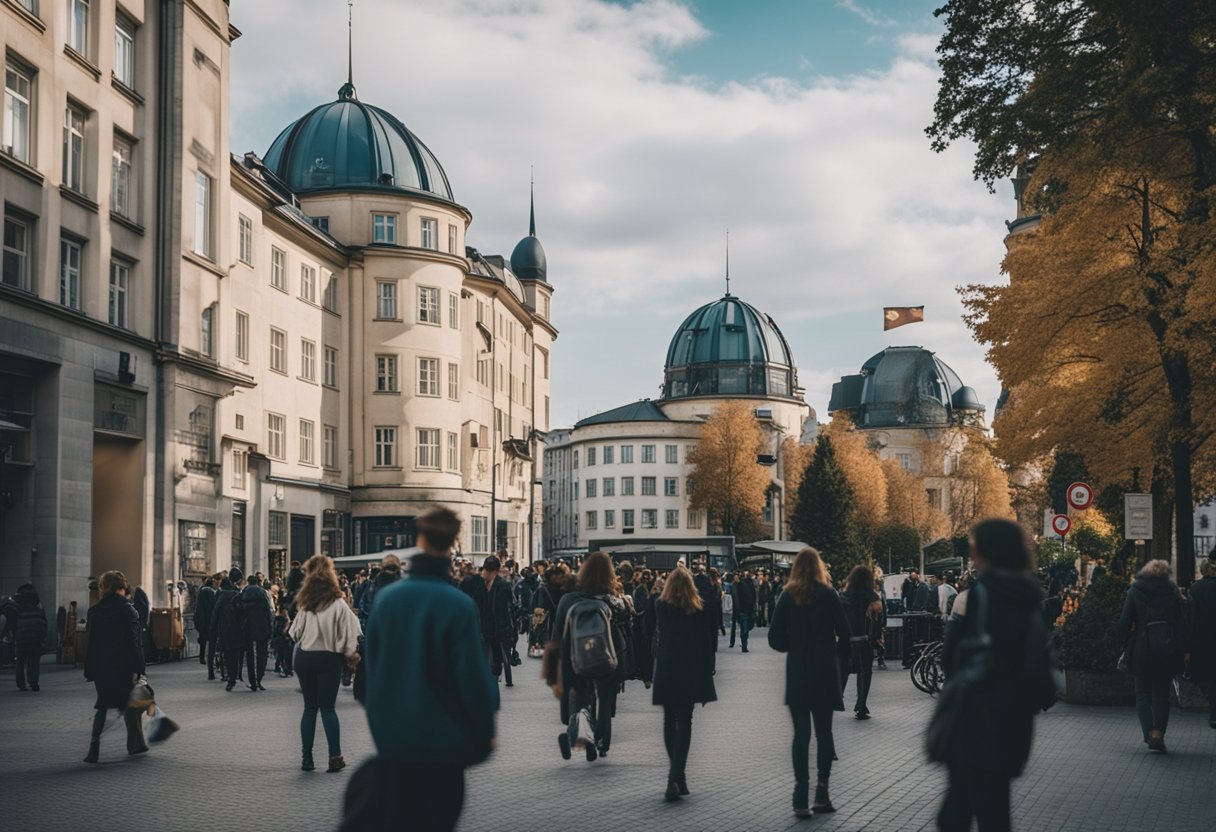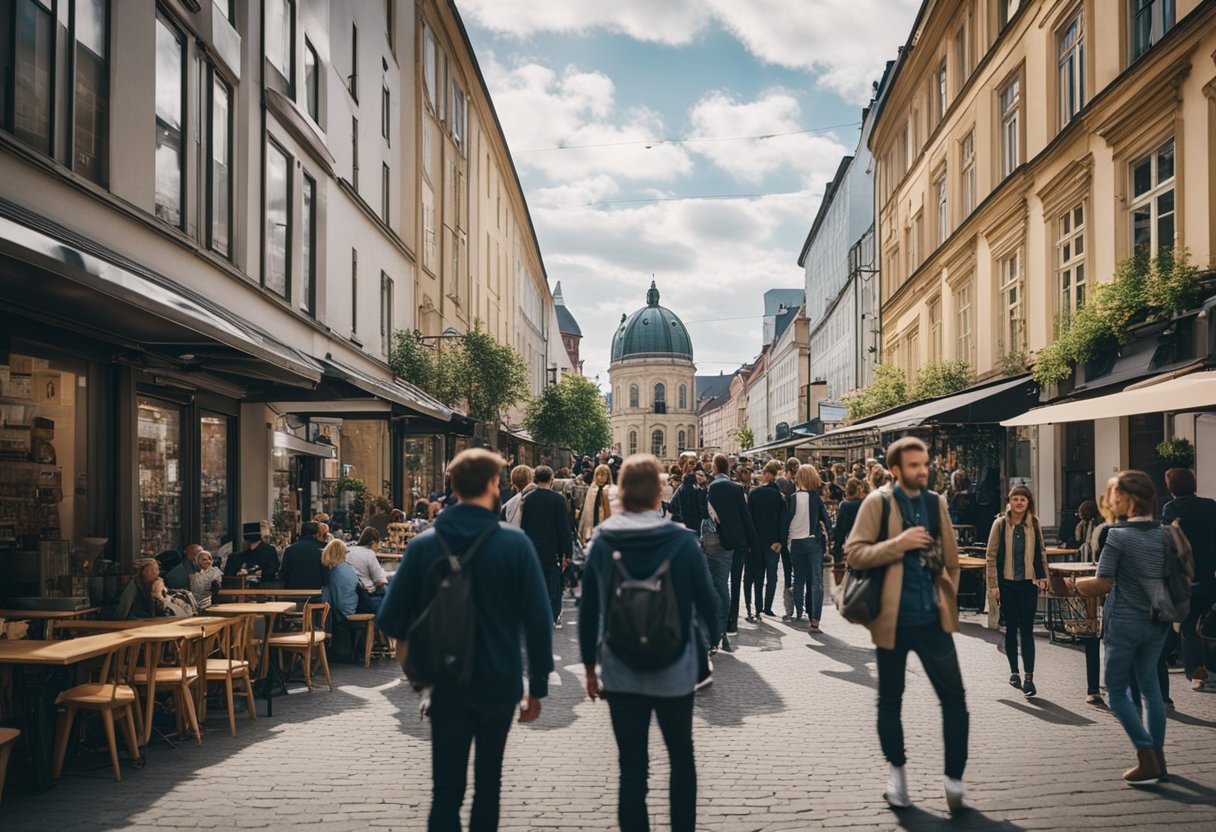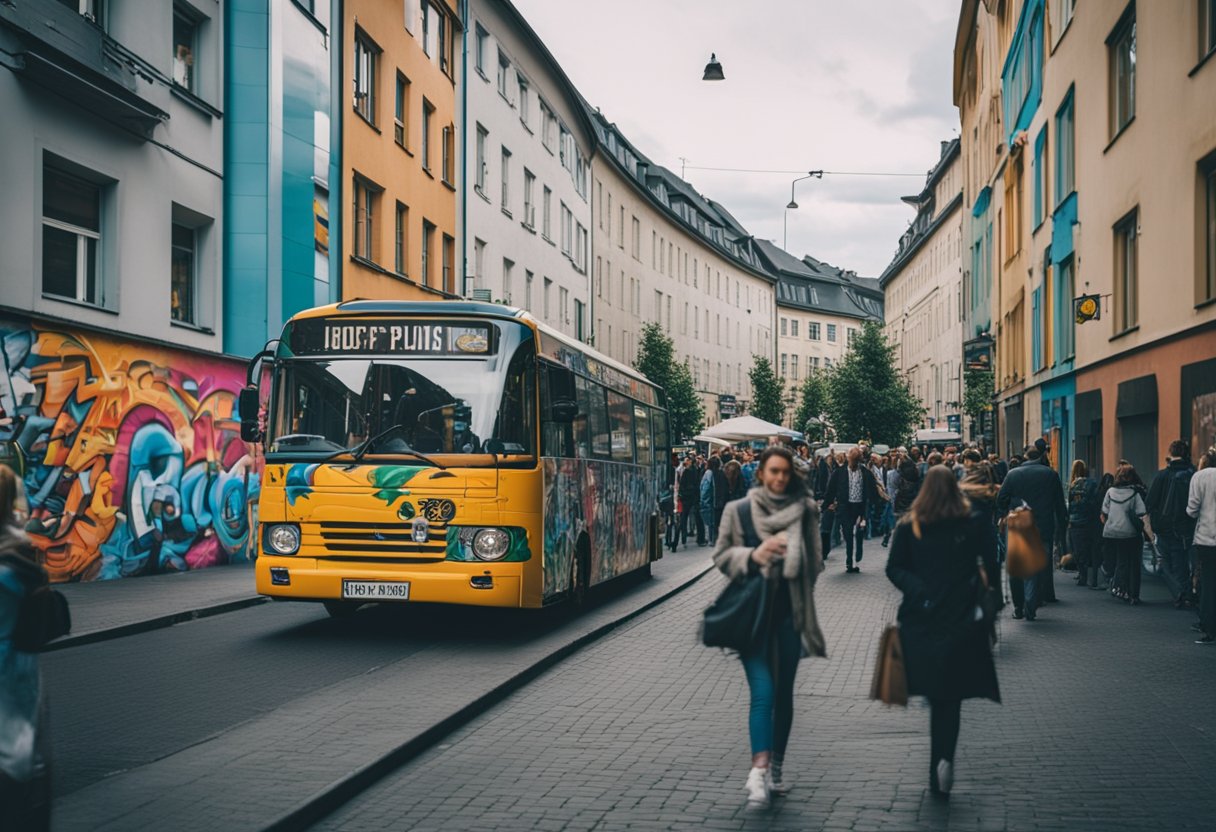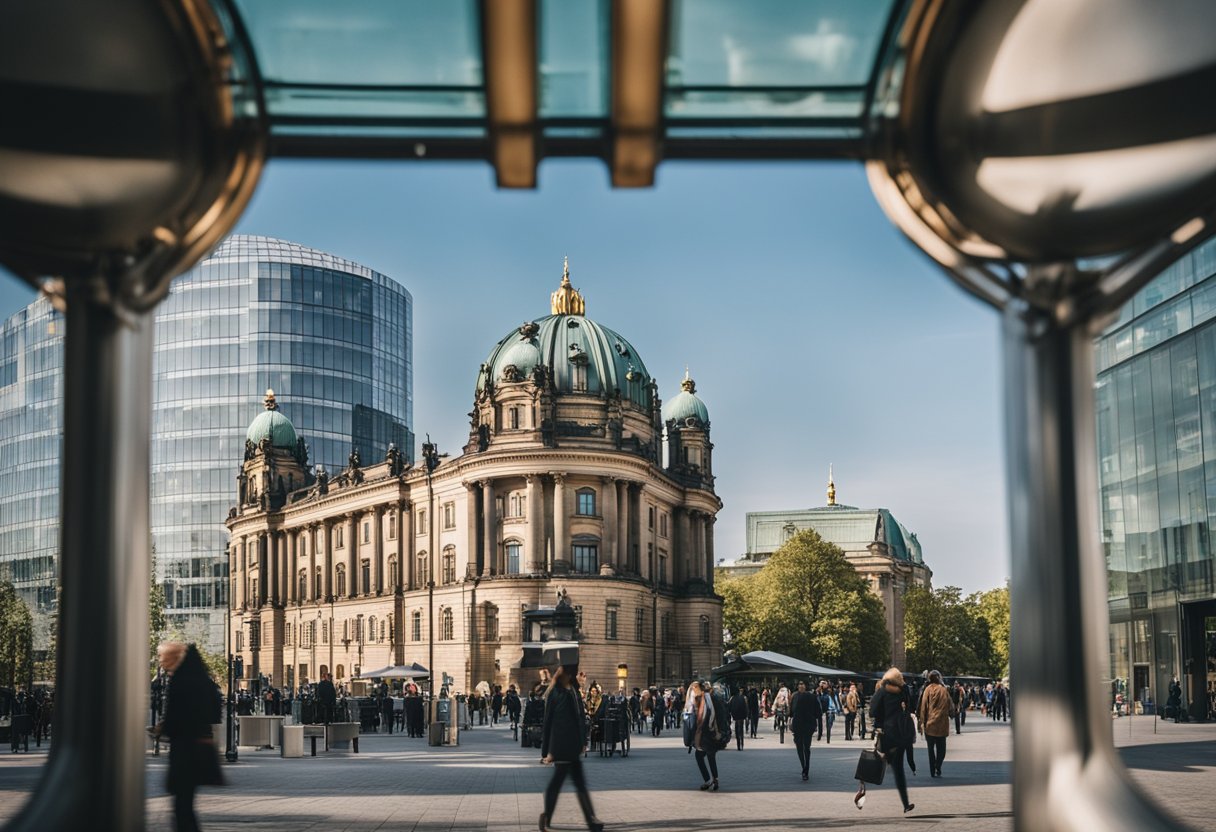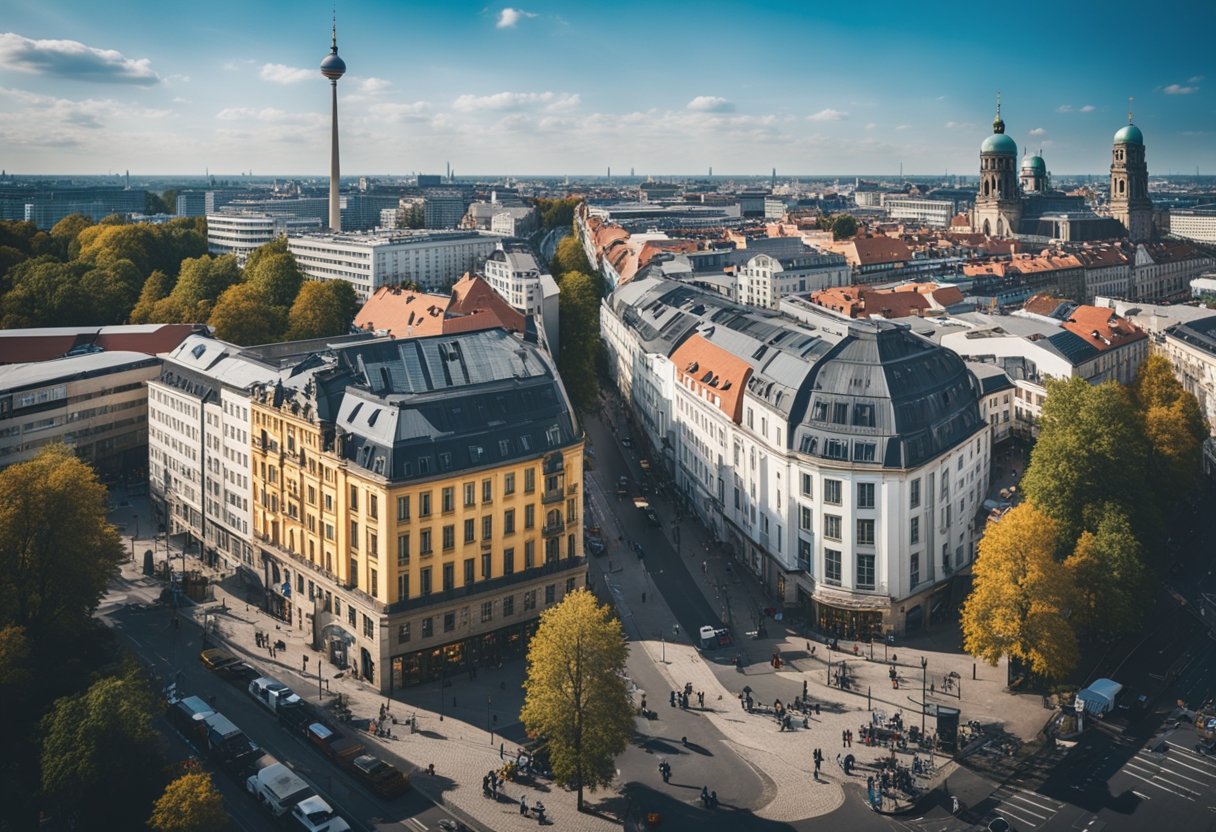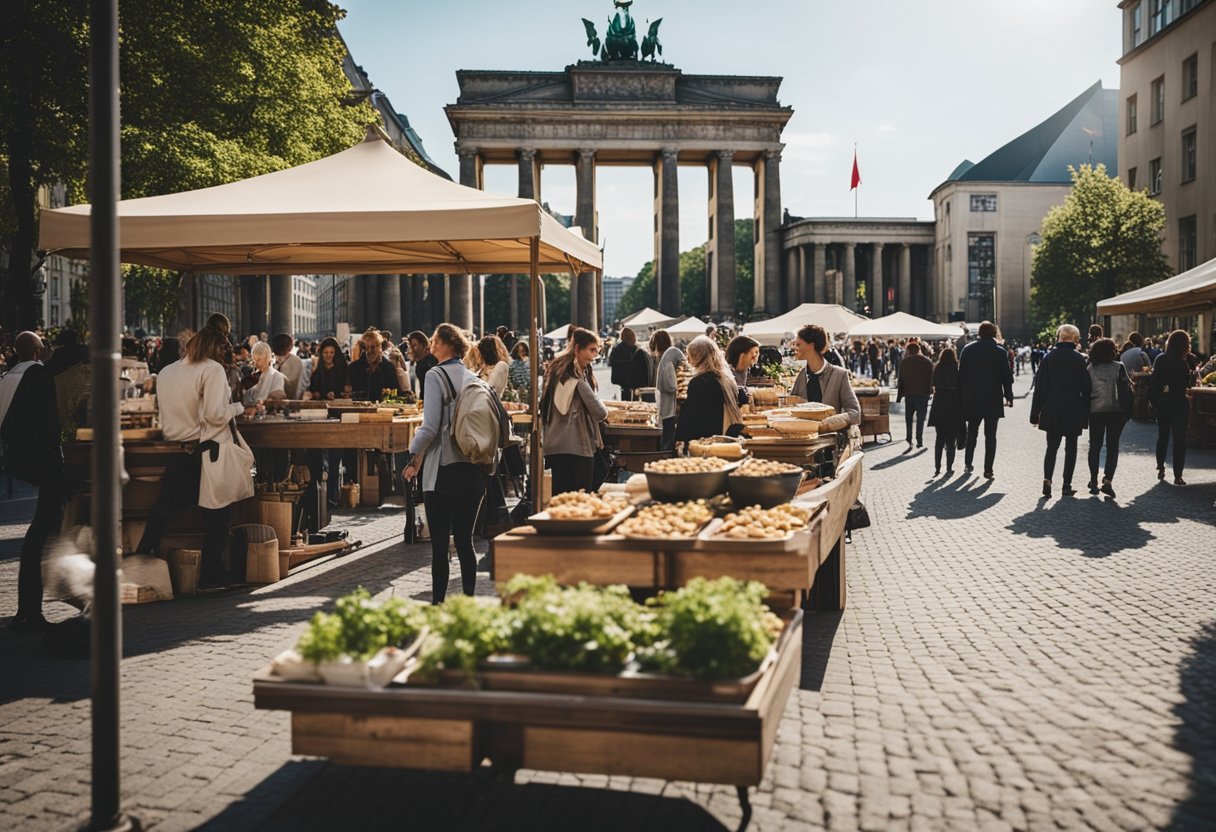Culture of Berlin is an intricate tapestry woven from its rich history and vibrant contemporary scene. This German capital stands as a cultural hub that has consistently reinvented itself, particularly since the fall of the Berlin Wall.
The spirit of creativity and freedom is palpable in its diverse artistic expressions, from the bustling energy of its famed nightlife to the thought-provoking works displayed in the multitude of galleries and on the street murals.
Known for its open and accepting nature, the city is a melting pot where traditions and innovations intersect. Berlin boasts an assortment of festivals, cultural events, and historic sites, creating an environment that celebrates both its profound history and its dynamic present.
The city’s inviting atmosphere has attracted talents and audiences from all over the world, making it a perennial destination for those seeking a rich and varied cultural experience.
Berlin’s historical significance is ever-present, with landmarks like the Gendarmenmarkt square and its cathedrals serving as reminders of its storied past.
However, the city is equally forward-looking, exemplified by the continuous emergence of new trends within its cultural scene. The result is a compelling, multifaceted culture that makes Berlin not just a place to learn about different cultures, but to live them.
Historical Context
Berlin’s culture is deeply intertwined with its complex history, from its origins to its role in shaping modern Europe. Each era has contributed layers to the city’s unique cultural identity.
The Formation of Berlin’s Identity
Berlin was founded in the 13th century and became the capital of the Margraviate of Brandenburg in 1417, signaling the city’s importance in regional politics.
The evolution of Berlin into a cultural hub was significantly influenced by the growth of Prussia during the 18th and 19th centuries, as it became the foundation of the German Empire in 1871. During the Weimar Republic, Berlin established itself as a center for innovation and modernism, laying the groundwork for its diverse and influential culture.
The Impact of the Berlin Wall
Post World War II divisions led to the construction of the Berlin Wall in 1961, splitting the city into East Berlin and West Berlin. This division drastically shaped the cultural landscape, with the East developing under the influence of the East German government, while the West turned into a symbol of freedom and Western culture. This period of physical and ideological separation left a lasting mark on the city’s identity.
Reunification and its Cultural Consequences
Reunification of 1990 brought together the contrasting cultures of East and West Germany, paving the way for an era of reconciliation and cultural renaissance.
Since reunification, the blending of these disparate influences has fostered an environment of creativity and freedom that characterizes Berlin’s culture today.
The capital of a reunified Germany thus stands as a testament to the enduring human spirit and its capacity to bridge divisions and forge a cohesive cultural identity.
Arts and Entertainment
Berlin’s cultural landscape is as dynamic as it is diverse, encompassing a rich tapestry of arts and entertainment that ranges from world-class museums to a vibrant music scene.
Museums and Galleries
Berlin is home to a multitude of museums and galleries, each offering a unique window into the realms of art, history, and culture.
The Neues Museum stands as a testament to ancient civilizations, while the Jewish Museum delves into the complex tapestry of German-Jewish history.
Art enthusiasts are drawn to the city’s thriving art scene, including numerous galleries and the iconic East Side Gallery, a symbol of freedom on the remnants of the Berlin Wall, also a UNESCO heritage site due to its historical significance.
Theater and Performance Arts
The German capital is renowned for its theater and performance arts, with establishments like the Berlin Cabaret offering contemporary and classic productions.
Berlin’s theaters are abuzz with a rich diversity of performances, from avant-garde works to traditional plays, maintaining a vital aspect of the city’s cultural heritage.
Music Scene
Berlin’s music scene is a pulsating epicenter of diverse sounds, from the classical compositions echoing within the Haus der Kulturen der Welt to the electronic beats that have defined Berlin as a global capital for techno.
The city’s orchestras and opera houses provide melodious experiences for classical music aficionados, while various clubs and venues keep the spirit of innovation and experimentation alive for contemporary music lovers.
Film and Media Industry
The film and media industry in Berlin is both historic and cutting-edge, with the Babelsberg Studios, the oldest large-scale film studio in the world, and contemporary media outlets like Deutsche Welle offering a glimpse into the city’s role as a hub for filmmaking and broadcasting.
The European Film Academy and annual Berlin International Film Festival place the city firmly on the map as a leader in cinema, fostering a vibrant community of filmmakers and enthusiasts.
Architecture and Urban Spaces
Berlin’s architecture is a tapestry of history and innovation, where iconic landmarks stand alongside modern urban constructions. The city’s dedication to green spaces and public areas contributes to its reputation as a culturally rich urban landscape.
Iconic Landmarks
Berlin is home to a number of iconic landmarks that reflect its rich past and commitment to remembrance and progress. The Brandenburg Gate is perhaps the most renowned, representing peace and unity following the division of the Cold War.
Nearby, both the French Cathedral and the German Cathedral grace Gendarmenmarkt, an area steeped in architectural beauty and historical significance.
The Reichstag, with its modern glass dome juxtaposed against the traditional facade, serves as a symbol of transparency in German politics.
Modern Urban Development
In recent times, Berlin has experienced significant urban development. Potsdamer Platz is a prime example, where avant-garde architecture creates a dynamic business and entertainment district.
The Mitte District showcases the transformation of Berlin, blending contemporary designs with classic structures. Alexanderplatz remains a hub of activity, dominated by the Fernsehturm’s slender spire, signaling Berlin’s skyward gaze. The panoramic city views from here offer a visual narrative of Berlin’s constant evolution.
Green Spaces and Public Areas
Berlin’s commitment to public spaces is evident along the banks of the Spree River, where residents and visitors alike can enjoy leisurely walks and vibrant cultural events.
The expansive Tiergarten, located in the heart of the city, offers a natural retreat from urban life. Kurfürstendamm is a bustling avenue that blends the charm of cafés and shops with the tranquility of tree-lined paths.
The prestigious Charlottenburg Palace, with its baroque style and surrounding gardens, invites a sense of serenity amidst the urban setting. Meanwhile, the Rotes Rathaus serves not only as a seat of government but also as a historical monument for public admiration.
Creative Economy and Design
Berlin’s culture is deeply intertwined with its vibrant creative economy, where the realms of fashion, design, publishing, and media not only thrive but also significantly contribute to the city’s identity.
Here, innovative design is not just an industry but a lifestyle, and media houses such as Springer are fundamental to the dissemination of creative content.
Fashion and Design Influence
The city’s fashion and design sectors are a testament to its standing as a creative capital. With dynamic trends and a flourishing scene of designers, Berlin is an international fashion destination.
The local design community is known for its commitment to sustainability and the ethical production of garments, distinguishing itself through a blend of functional and avant-garde styles.
Publishing and Media
In publishing and media, Berlin is a powerhouse, housing over 22,600 creative enterprises and fostering a culture of innovation in these fields. The city boasts a diverse publishing landscape, ranging from influential global players like Springer to niche independent publishers.
The media industry in Berlin stands at the forefront of embracing digital transformation, ensuring its role as a key player in an ever-evolving creative economy.
Cultural Diversity and Society
Berlin’s cultural tapestry is woven from a diverse blend of history, communities, and ongoing movements. It reflects a broad spectrum of influences from the historic neighborhoods of Mitte and Kreuzberg to the artistic energy of Friedrichshain and Prenzlauer Berg.
Multicultural Berlin
Berlin is a city where diversity thrives, and nowhere is this more evident than in its neighborhoods. Kreuzberg is famous for its large Turkish population, which adds a vibrant mix of cultures and cuisines to the district.
Meanwhile, Mitte, the central borough, embodies the blend of historic and contemporary influences, hosting numerous cultural institutions.
Friedrichshain and Prenzlauer Berg are characterized by a dynamic mix of international artists and young cohorts adding to the European culture landscape of the city. This fusion makes Berlin not just a German metropolis but also a European cultural hub.
Youth Culture and Movements
Young people play a pivotal role in shaping Berlin’s societal fabric, from electronic music clubs to underground art scenes. Berlin’s youth culture is not just a byproduct but a driving force that influences everything from nightlife to street fashion.
The city’s history with movements such as the Weimar era’s avant-garde and post-reunification subcultures continues today through political activism and social expression. These movements keep the spirit of diversity alive and foster a progressive and inclusive atmosphere for all Berliners.
Lifestyle and Leisure
Berlin’s lifestyle and leisure activities reflect its dynamic cultural diversity and its status as a hotspot for both culinary delights and electrifying nightlife. The city’s amalgamation of global influences and local traditions makes it a unique destination for food enthusiasts and party-goers alike.
Culinary Scene
Berlin’s culinary landscape is a tapestry of flavors, catering to a wide array of tastes and preferences. Restaurants in Berlin range from traditional German eateries to international gourmet destinations.
One can indulge in hearty local dishes such as Currywurst and Schnitzel or explore upscale dining experiences. Food markets and street food vendors also play a crucial role in the city’s food culture, offering an accessible way to enjoy diverse cuisines.
Nightlife and Clubbing
Nightlife in Berlin is synonymous with its world-renowned club scene. Iconic venues like Berghain and Tresor draw crowds from across the globe, synonymous with cutting-edge electronic music and an inclusive, avant-garde atmosphere.
The clubbing experience in Berlin is not just about music but also represents freedom of expression. The city’s array of bars complements its club scene, offering more laid-back environments to socialize and unwind.
Festivals and Public Events
Festivals and public events are deeply ingrained in Berlin’s social fabric. Events such as the Karneval der Kulturen celebrate the city’s multicultural spirit through parades, music, and dance.
In addition to cultural festivals, Berlin hosts various music and film festivals throughout the year, showcasing both local talent and international stars. These events provide residents and visitors with diverse opportunities to engage with the arts and each other in communal settings.
Recognition and Preservation
Berlin’s cultural scene is not only vibrant but also carefully preserved, with efforts recognized on a global scale.
This recognition and the city’s commitment to protecting its cultural heritage are evident in its UNESCO World Heritage Sites and the safeguarding of its artistic legacy.
UNESCO World Heritage Sites
Berlin is home to several UNESCO World Heritage Sites, which embody the city’s rich history and dedication to preservation. Museum Island, situated in the heart of Berlin on the Spree Island, is a notable example.
This ensemble of museums is celebrated for its architecture, collection, and the embodiment of ideas about the free accessibility of art and education. It serves as a testament to the city’s commitment to safeguarding its cultural assets.
Protection of Artistic Heritage
The artistic heritage of Berlin extends beyond museums and into the vibrant street art scene, which receives a level of protection and appreciation uncommon in many other cities.
This commitment to contemporary culture allows the street art scene to flourish, acting as a canvas that reflects the city’s historical layers, societal changes, and current issues.
The juxtaposition of historical sites beside modern expressions of culture illustrates Berlin’s unique approach to valuing and protecting its diverse artistic heritage.
Frequently Asked Questions
Berlin’s culture is a vibrant tapestry that reflects its rich history and contemporary dynamism. The city’s identity shines through a plethora of cultural events and an eclectic food scene, celebrating both tradition and modernity.
How do Berlin’s cultural events and festivals reflect the city’s identity?
Berlin’s identity is vividly expressed through its diverse and vibrant nightlife, including an array of festivals that celebrate everything from music and film to art and pride. These events often speak to Berlin’s history of openness, rebellion, and creativity.
What are the key historical influences on Berlin’s contemporary culture?
The city’s contemporary culture is deeply influenced by pivotal historical events, such as its central role in WWII and the Cold War. Berlin has evolved with a focus on remembrance, freedom of expression, and an inclusive approach to its changing cultural dynamics.
How is Berlin’s food culture representative of its diverse population?
Berlin’s food culture has become a reflection of its melting pot status, with a wide range of cuisines showcasing the city’s multicultural inhabitants. It features everything from traditional German dishes to a broad spectrum of international flavors.
What traditional customs and celebrations are unique to Berlin?
Berlin hosts unique customs and celebrations, like the famous Karneval der Kulturen, which revels in the city’s multicultural spirit. Additionally, traditional events such as Christmas markets capture Berlin’s unique charm.
In what ways does Berlin’s artistic scene contribute to its overall cultural landscape?
The artistic scene in Berlin contributes significantly to its cultural aura, with an expansive street art landscape, pioneering music, and avant-garde theatre. These artistic endeavors personify Berlin’s reputation as a hub for artists and creatives.
How do the various cultures within Germany shape the specific culture of Berlin?
Berlin’s culture is shaped by the myriad influences of various German regions, integrating Bavarian, Rhineland, and North German traditions into a distinctive Berliner ethos. This intermingling creates a cultural experience that is both uniquely Berlin and distinctively German.
